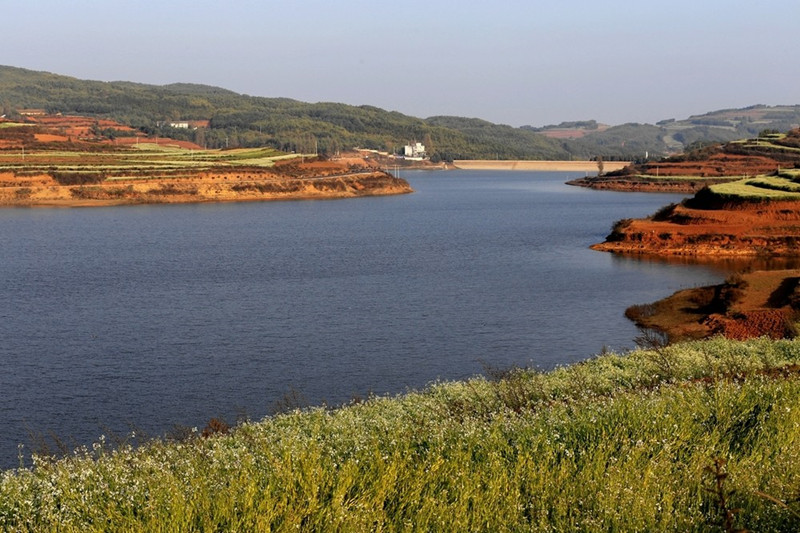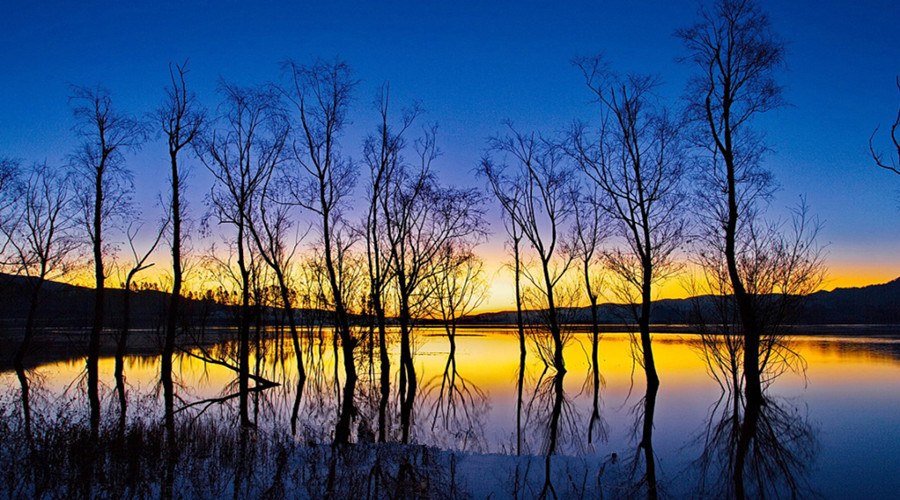Yiwu,The Hometown of Pu’er Tea. Yiwu Town is situated in the north of Mengla County, Xishuangbanna Prefecture. It is the hometown of Pu’er Tea as well as the starting point of the Ancient Tea-Horse Trail (Road). In old times, Yiwu was known as a commercial city. It serves as the linkage between China and Laos and an important gateway to the Southeast Asia. The Yiwu name has picked up considerable steam and now carries significant sway in the pu’erh market. As a result, what is marketed as Yiwu tends to come from a very large area.
Why is Yiwu Mountain so special?
As the hometown of Pu’er Tea, Yiwu has conserved in good conditions historical relics of the “Ancient 6 Teas Mountains”. Strolling on the old streets of Yiwu, one will be greeted by time-honored trademarks of tea businesses such as Cheshun, Qianlizhen, Anle and Tongxing etc. Tea trees can be found in every mountain, and every village plants tea. This is exact appearance of Yiwu Tea Mountain.
Where is Yiwu Mountain?
Yiwu Tea Mountain is located in the north of Mangla County, Xishuangbanna Prefecture, Yunnan. Yiwu Mountain ioffers heavy fog, fertile land, warm and rainy, rich in heat and abundant rainfall, which are good for plantation of tea.
Main Tea Mountains and Villages in Yiwu Tea Mountain
When it comes to Yiwu, we often see descriptions such as “the birthplace of Pu’er tea,” “the queen of tea,” “a historical record of tea,” “the foremost among the Six Ancient Tea Mountains,” “the origin of tribute tea on the Tea Horse Road,” and “the destination for tea enthusiasts.”
Such high praise for Yiwu is not without reason. If you delve deeper into understanding and tasting Yiwu tea, you will come to know of its glorious past and experience its gentle yet assertive character, which is incredibly captivating!
The Foremost of the Six Ancient Tea Mountains—Yiwu Tea Region
The Yiwu Ancient Tea Mountain, located in Yiwu Township, Mengla County, Xishuangbanna, Yunnan Province, borders Laos to the east and is surrounded by the Yao region, Menglun, Xiangming, and Manla on the south, west, and north sides. It lies in the eastern part of the Six Ancient Tea Mountains. The term “Yiwu” in the Dai language means “the place where beautiful snakes reside.”
The Yiwu Ancient Tea Mountain covers an area of approximately 750 square kilometers, making it the largest among the Six Ancient Tea Mountains. It includes Yiwu Zhengshan, Mansa Tea Mountain, and Manla Tea Mountain. Due to its large area, it is referred to as the Yiwu Tea Region. Yiwu Tea Mountain is the largest in the Six Ancient Tea Mountains, with a saying that “Yiwu occupies one and a half of the Six Tea Mountains.”
One Yiwu Mountain, Half a History of Pu’er
Yiwu has a long history of tea cultivation. Legend has it that tea existed in Yiwu Tea Mountain during the Han Dynasty, and Kongming (Zhuge Liang) taught the methods of picking and drinking tea when he arrived, leading Yiwu people to call Kongming the “Tea Ancestor.” By the Tang Dynasty, various ethnic groups such as the Hani, Blang, Wa, and Yi were already living in Yiwu and cultivating tea. During the late Ming and early Qing Dynasties, Yiwu gained prominence, with its Pu’er tea being exported to Tibet, Southeast Asia, and other regions. To facilitate the transportation of tribute tea and large quantities of tea, goods, and people, the Tea Horse Road centered in Yiwu was established during the Daoguang era, radiating in all directions. During the peak tea production seasons, the number of people coming to buy and transport tea reached tens of thousands, making it a bustling hub of commerce and mule traffic.
As Pu’er tea has become more widely recognized and accepted, it has evolved into a healthy, fashionable, and elegant green beverage. Yiwu tea, with its unique flavor, has once again risen to the pinnacle of Pu’er tea.
The historical influence of Yiwu tea is profound, and it is regarded as the destination for tea enthusiasts. Many tea connoisseurs enjoy tasting and collecting Yiwu tea, finding a sense of belonging in its unique flavor during their search.
The “Queen” of Pu’er—Yiwu Tea
We often hear “Ban Zhang is the king, Yiwu is the queen.” But did you know that “queen” comes first and “king” comes later? When Ban Zhang tea was still relatively unknown, Yiwu tea was already mentioned in Lu Yu’s “The Classic of Tea,” and the Six Ancient Tea Mountains were thus well-known. This highlights the significant reputation of Yiwu tea!
While Ban Zhang tea is known for its bold flavor like a domineering king, Yiwu tea is known for its delicate taste, like a gentle queen. In contrast, Yiwu tea is softer and less domineering, with very low bitterness and high sweetness. The tea soup is very delicate, with a smooth and gentle texture, and features a refreshing and floral honey aroma. Especially after aging, the tea has a flavor that lingers pleasantly.
The taste and aroma of Yiwu tea are closely related to its ecological environment.
Yiwu Ancient Tea Mountain ranges from 656 to 2023 meters in altitude, with significant elevation differences. It belongs to the northern tropical humid monsoon climate, characterized by warm and moist conditions. The high mountains are often shrouded in mist, and the land is fertile with abundant rainfall.
The soil in the tea region mainly consists of red soil and yellow soil. This unique acidic soil quickly accumulates nutrients and facilitates rapid decomposition and utilization, with high organic matter content. The ancient tea tree distribution area has well-preserved vegetation and high forest cover, creating an excellent ecological environment unmatched by other tea regions.
Yiwu’s “Seven Villages and Eight Hamlets”
Seven Villages:七村:麻黑村、高山村、落水洞村、曼秀村、三合社村、易比村、张家湾村;
- Mahei Village
- Gaoshan Village
- Luoshui Cave Village
- Manxiu Village
- Sanheshe Village
- Yibi Village
- Zhangjiawan Village
Eight Hamlets:八寨:刮风寨、丁家寨(瑶族)、丁家寨(汉族)、旧庙寨、倮德寨、大寨、曼洒寨、新寨。
- Guafeng Hamlet
- Dingjia Hamlet (Yao ethnic group)
- Dingjia Hamlet (Han ethnic group)
- Jiuhmiao Hamlet
- Luode Hamlet
- Dazhai Hamlet
- Mansa Hamlet
- Xinzai Hamlet
While everyone knows about the tender and gentle taste of Yiwu tea, it is less known that each of Yiwu’s “Seven Villages and Eight Hamlets” has its own unique charm. To describe Yiwu tea solely with its tender and gentle characteristics would indeed be an understatement of its title as the queen of Pu’er tea!
Yiwu’s Seven Villages and Their Unique Qualities
Yiwu’s Seven Villages: Mahei Mahei is one of the oldest villages in Yiwu and is considered a benchmark for Yiwu tea due to its influence in the region. It has been famous since the Qing Dynasty for its tribute tea, and today it remains one of the largest and highest-yielding ancient tea garden areas in Yiwu.
Characteristics: Mahei tea features broad, dark green leaves with tight, well-formed, and glossy buds. It has a distinctive aroma and rich tea flavor. The tea soup is clear and bright, representing the Yiwu characteristic of “fragrant and soft.”
Yiwu’s Eight Hamlets: Guafeng Hamlet Guafeng Hamlet is a purely Yao ethnic village bordering Laos, located 31 kilometers from the township government, and is quite remote. It has the highest altitude among the Yiwu Seven Hamlets, averaging around 1700 meters, and is known for having the most well-preserved ancient tea trees.
Characteristics: The ancient tea trees in Guafeng Hamlet are distributed across about 50 square kilometers of pristine forest. The tea produced here is known for its sweet and rich honey aroma, strong and subtle tea flavor, deep throat aftertaste, and a full-bodied tea soup. Guafeng Hamlet’s ancient tree tea is considered a high-end Pu’er tea with top standards.
Yiwu Tea Region’s Newcomer: Bohetang Bohetang, located in the deep mountains of the Yiwu Mansa Tea Region, has an altitude of about 1800 meters. The tea trees here are scarce and extremely old, with unique and valuable qualities, making it a benchmark tea in Yiwu.
Origin of the Name: The name “Bohetang” is said to originate from the Yao ancestors who, while planting spices in the deep mountains, accidentally discovered a tea garden with naturally growing “mint,” thus naming it “Bohetang.”
Characteristics: Bohetang tea has long stems, thick and solid buds, with a rich and high-aroma fragrance. The tea soup is a vibrant golden color, smooth and mellow, with a delicate texture. It has a refreshing and sweet taste with a wild, thick, and slightly cool sensation, truly making it a gem among teas.
Characteristics of Yiwu Tea Mountain Pu-erh Tea
Yiwu Pu-erh tea, produced in the Yiwu Mountain area of Yunnan Province, China, is renowned as one of the finest Pu-erh teas and is celebrated with the title “King of Tea.” The high regard for Yiwu Pu-erh tea is closely tied to its unique taste characteristics. This article will explore the taste profile of Yiwu Pu-erh tea in detail, allowing you to experience the charm of this tea treasure.
Yiwu Pu-erh tea is typically shaped into cakes, with a dark, lustrous appearance and tightly rolled leaves. The tea liquor is deep red and bright. The taste characteristics of Yiwu Pu-erh tea are primarily reflected in the following aspects:
- Rich FlavorYiwu Pu-erh tea is known for its rich flavor. The tea liquor is full-bodied and has a strong aftertaste. This rich taste comes from various components in the tea leaves, such as polyphenols and amino acids. During tasting, you can experience the tea’s complex layers in your mouth, as if savoring the sediment of time and the vicissitudes of history.
- Unique AromaThe aroma of Yiwu Pu-erh tea is distinctive, with strong aged and woody notes. This aroma evokes the feeling of being in a dense forest, experiencing the freshness and tranquility of nature. As you drink, the aroma gradually emerges with the flow of the tea, creating an immersive experience.
- Sweet Aftertaste and SalivationYiwu Pu-erh tea is known for its prominent sweet aftertaste and salivation. After the tea enters the mouth, it quickly spreads, bringing a sweet sensation. Additionally, the salivation effect is noticeable, providing a sense of moisture and comfort in the mouth. This sweet aftertaste and salivation contribute to Yiwu Pu-erh tea’s excellent reputation among tea enthusiasts.
- High BrewabilityYiwu Pu-erh tea has a high brewability, typically allowing for more than ten infusions, or even more. During multiple infusions, the tea’s taste and aroma remain consistent. This high brewability makes Yiwu Pu-erh tea a great value, enabling you to fully enjoy its unique charm.
- Significant Health BenefitsYiwu Pu-erh tea not only offers a unique taste but also provides notable health benefits. It is rich in polyphenols, caffeine, and other substances that help lower blood lipids, aid weight loss, and offer antioxidant properties. Regular consumption of Yiwu Pu-erh tea not only satisfies the palate but also positively impacts overall health.
- Rich Historical and Cultural HeritageYiwu Pu-erh tea has a long history and deep cultural significance. It carries the historical weight of the ancient Tea Horse Road and witnesses the transmission and development of Pu-erh tea culture. Drinking Yiwu Pu-erh tea allows you to appreciate its unique taste characteristics and also savor the profound essence of Pu-erh tea culture.
In summary, Yiwu Pu-erh tea stands out in the Pu-erh tea world with its rich flavor, unique aroma, sweet aftertaste, high brewability, significant health benefits, and profound historical and cultural heritage. Tasting Yiwu Pu-erh tea is not only a sensory pleasure but also a spiritual experience, allowing you to enjoy the distinctive charm of Pu-erh tea culture.
How to Get to Yiwu Mountain?
Travelers can get to Mengla County at first, then change bus or take local motorbike to Yiwu Tea Mountain. It is also a good idea to cycle or hike to Yiwu Mountain.
Long-Distance Bus is an important way getting to Mengla County, which could be accessible from Kunming, Jinghong, Puer, Luang Prabang, etc. Here we list some of the bus information for your reference.
| Route | Departure Station | Departure Time |
| Kunming-Mengla | Kunming South Passenger Station(南部客运站) | 10:30, 19:00, 19:30, 18:00 |
| Kunming-Mengla | Kunming High-speed Rail South Passenger Center(昆明高铁南客运中心) | 11:00, 18:00, 20:00, 20:30, 21:30, 22:00, 22:40 |
| Kunming-Mengla | Kunming North Passenger Station(北部客运站) | 21:00 |
| Puer-Mengla | Puer High Speed Passenger Station(普洱高快客运站) | 07:00, 08:10, 09:10, 10:10, 12:50 |
| Jinghong-Mengla | Jinghong Passenger Station | 07:10, 08:00, 09:00, 10:00, 11:40 |
History of Yiwu Mountain
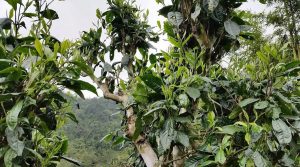
Historically, Yiwu is famous for being the center of distribution for tribute tea to be sent to the emperor. The six famous tea mountains produced mao cha where it would be collected and sent out to Beijing from Yiwu. This trade brought a large number of Han merchants (the principle Chinese ethnic group) to the area to trade tea (source). Some of the more famous examples of aged pu’erh (from the 1930s) also originated here. i.e. Fuyuanchang, Tongqin Hao and Songpin Hao.
From the 1940s until the 1990s, tea production shifted away from these regions to Menghai County where Menghai Tea Factory planted ground. During this period, tea that was produced was usually unceremoniously sold as raw mao cha to the larger factories.
When China began to open up to the west, many Taiwanese traders visited Yiwu hoping to find both tea production and more aged tea. They found neither, but ended up helping the locals to restart tea production. As a result, the greater Yiwu area has strong ties with the Taiwanese market. Many of the Taiwanese pu’erh brands have strong ties to this region. This is covered far more thoroughly in Zhang Jinghong’s Ancient Caravans and Urban Chic.
In Zhang’s book she characterizes the Taiwanese and Yiwu style as emphasizing the hand-made and traditional aspects of tea-making, a supposed contrast from the more production oriented Menghai County tea. Yiwu tea operations tend to be smaller, often family-oriented, whereas Menghai County is more densely populated with major operations, i.e. Menghai Tea Factory .
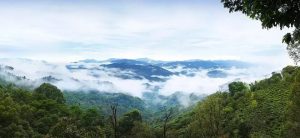
Main Attractions and Things to Do in Yiwu
1.Characteristic Taste
Yiwu is known for a distinctive softer, less punchy base with a long-lasting sweet aftertaste when compared with other pu’erh regions, i.e. Bulang/Banzhang. There are a number of growing regions within the greater Yiwu area, including the six famous tea mountains. These areas all represent Yiwu to some extent, although there will even be significant variation moving from one region to the next.
Note #1: Because Yiwu is a township and a county, it is ambiguous as to what exactly constitutes “Yiwu”. This has not stopped tea producers from constantly marketing and using the Yiwu name to sell tea.
2.Karst Sightseeing
Yiwu also is endowed with Karst sights some of which are Huashegongzhu Cave (Cave of Princess Snake), Nametiancaiyun Cave (Colorful Clouds Cave) and Gaoshanluoshui Cave etc.
Snake Princess Cave
About 500 meters in the northeast of Yiwu, the Snake Princess Cave is in fact a dolomite. It’s known for the patriotic poems by Xu Ziheng, Li Shouchang and Dao Chengzhang all of whom were officials in the Qing Dynasty.
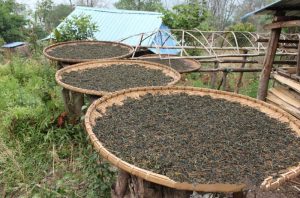
Nametiancaiyun Cave
More spectacular than the Snake Cave, Nametiancaiyun Cave is noted for stalagtites and stalagmites all of which are queerly shaped. It integrates natural and cultural sights, tropical rain forests and Karst caves, thus bringing forth picturesque sceneries.
3.Ethnic Minority
Yiwu is a multi-ethnic village, there are many ethnic live here together, such as Han, Yi ethnic, Dai ethnic, Yao ethnic, Hani ethnic.
Yi people are indigenous group of Yiwu village, which can date back to Han Dynasty. Diligent and kind Yi people keep a simple life style, work with sunrise and stop at sunset.
The Torch Festival is a traditional festival for the Yi ethnic group. It falls on the 24th of the sixth month of the Chinese calendar, and the celebration lasts for 3 days. The origin of the festival is related to ancestors’ worshipping of the fire, which is believed to have the power to repel insects, ward off evils, and protect the growth of crops. In some villages, it is a tradition for the elderly to pass down their farming experience to the younger generation during the festival.
During the festival, big torches are erected in the village, while small torches are placed in front of each household. When the night falls, an altar is set up and the holy flame is lit up. The Bimo (village flamen) will chant prayers, light up torches from the flame, and pass them to the villagers. Villagers, holding the flame, walk around the village, houses and the fields, and place the torches in the field corners to drive away evils. Inside the village, young men and women sing and dance around bir burning torches throughout the night.
Recommended Tours
3 Days XishuangBanna Tea Culture Tour to Yiwu and Nannuo Tea Mountains
6 Days XishuangBanna Yiwu Mountain Tea Culture Hiking Tour
11 Days XishuangBanna and Puer Ancient Tea Culture Tour with Yiwu Mountain Tea Plantation
Nearby Attractions
Menglun Tropical Botanical Garden
Xishuangbanna Tropical Botanical Garden (Chinese name: 西双版纳热带植物园) was built in 1959, is the biggest and richest botanical garden in China nowadays. Since 1996, this garden combined with former Kunming Ecological Research Institute, formed an independent research institution attached to Chinese Academy of Science. With the time goes by, it becomes a comprehensive garden that combined research, preservation and education of tropical plants together.
Wangtianshu Scenic Attraction is the only oasis at 21 degrees north latitude, and has been recognized internationally as China’s unique tropical rainforest. What is the most impressive in the park are the towering Shorea chinensis (Sky Trees) that are the rainforest iconic images in South and Southeast Asia. An Air Corridor (Kong Zhong Zou Lang), 2500 meters long and 36 meters high, has been built on the high canopies. It remains a challenge to both visitors and scientists. The well-protected tropical rainforest that was discovered by the Chinese reputed botanist Mr. Cai Xitao (1911-1981) and witnessed by Prince Philip of the UK, surprised many people when it was unveiled to the outside world. With hotels and air corridor, you can travel and lodge here.
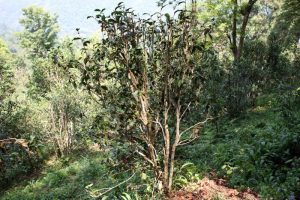
Best Time to Visit
Belonging to tropical rainforest climate, Xishuangbanna’s dry season is from November to April the next year and rainy season is from May to October. With annual average temperature of 21 c, it has long summer and no winter. With cool and pleasant four seasons, the best time for traveling Xishuangbanna is from October to June the next year.
Useful Travel Tips
Local Cuisine
During your visit to Yiwu, you definitely shouldn’t miss the local cuisine. Yiwu boasts a unique culinary culture with a variety of dishes and distinctive flavors. You can enjoy authentic Yunnan cuisine and ethnic specialties in local restaurants, such as: cured pork ribs, wild mushrooms, and Dai-style sour and spicy fish. Additionally, Yiwu’s tea is also a highlight; you can sample local Pu-erh tea, green tea, and other delicious varieties.
Shopping Recommendations
While in Yiwu, you can also purchase local handicrafts and specialty products as souvenirs or gifts. Yiwu is known for its exquisite embroidery and weaving crafts, such as handmade embroidered shoes and embroidered scarves. Local tea and tea utensils are also great choices. When shopping, it is advisable to choose reputable merchants to avoid low-quality or counterfeit products.
Important Tips
- Safety Concerns: During your travels, be mindful of personal and property safety. Avoid going to undeveloped or unsafe areas to prevent potential dangers. Exercise caution when walking in mountainous or steep areas.
- Environmental Awareness: Protecting the environment is the responsibility of every traveler. Follow local environmental protection regulations, avoid littering, and do not damage natural landscapes or cultural relics. Also, respect local customs and cultural traditions.
- Respect Local Residents: Be considerate of the local residents’ lifestyles and habits. Try not to disturb their daily lives and respect their work and cultural traditions. When taking photos, always ask for permission from local residents first.
- Travel Planning: Given Yiwu’s limited transportation options, it’s recommended to plan your itinerary in advance and allow enough time to explore various attractions. Also, pay attention to the pace of your itinerary and avoid overexertion.
Zhanglang Bulang Ethnic Minority Village
Zhanglang Bulang Ethnic Minority Village(章朗布朗古寨) is the only one Bulang ecologic museum in China. The Bulang people have been inhabitants of the area for thousands of years. Zhang is elephant, and Lang means frozen in Dai language. Zhanglang is the place of elephants getting frozen. It enjoys long history, over a thousand years. It also keep the traditional culture and historic relics completely. Zhanglang village can take you back to know more about history. It is waiting for you to discover.
Chinese Name: 西双版纳傣族自治州勐海县西定乡章朗村
English Name: Zhanglang Village of Xiding Town in Menghai County, Xishuangbanna
Why is Zhanglang Bulang Ethnic Minority Village so special?
Zhanglang Bulang Village is like a living fossil, enjoying the ancient temple , ancient well and ancient trees. It carries not only the traditional culture of Bulang minority, but also the tea culture.
Where is Zhanglang Bulang Village?
It is located in Xiding Town of Menghai County, 70 km from Menghai County and 100 km from Jinghong City. It is surrounded by the primeval forest and wild tea trees.
How to Get to Zhanglang Bulang Village
There is no bus to Zhanglang Village. Travelers can drive or cycle to this ancient village.
Legend
Zhanglang means the place of elephants getting frozen in Dai language. 1400 years ago, Mahahong, the disciple of Sakyamuni, traveled around the world by riding elephant. When they came here, it rained cats and dogs, with hails. The rain did not stop until the night. They had to live in local Buddhist Temple. The elephant was frozen the next day. Mahahong named the village as Zhanglang to memory the contribution of elephant.
More Information about Zhanglang Village
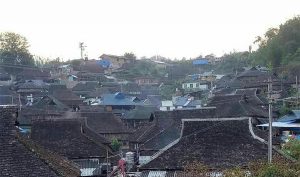
Drive from Menghai County, and across Mengzhe Town, hillup the mountain, via Bada mountains, you can see the Zhanglang Village, with 70 kilometers from Menghai County. From afar, the Zhanglang Village with thousand years is hidden in the virgin forest. The top of mountain standing a pagoda with unique style.
Bulang Ethnic Minority
The Bulang ethnic (also known as Blang) are one of the ethnic minority groups of southwestern Yunnan province. There are approximately 90,000 Bulang people remaining in China. There’s the highest density of Bulang natives as well as the Lahu people in the Menglai area of southwest Yunnan. Many of these villages are easily accessible on a trip to Xishuangbanna. Nonyang is a town located in the Xishuangbanna prefecture and a few kilometers from Menghun, it’s one of the main spots for the Bulang people. Pass the mountains in Menghun and the territory extends to the Myanmar border. Most of the Bulang villages are over 1,500 meters above sea level. In many villages the traditional-style Bulang houses remain standing.
They believe in original religion in ancient time, and now believe in Buddhism. It is very secure there as there is no single crime in Zhanglang Village since the founding of People’s Republic of China.
Tea Culture of Zhanglang Village
Zhanglang tea is famous for its high-quality and long history. Tea is a kind of life style. For a thousand year, the village keeps the traditional tea culture. Zhanglang village is embraced by tea trees planted by their ancestors. Bada Ancient Tea Plantation is main plantation. It is a ideal place for you to get back and experience life.
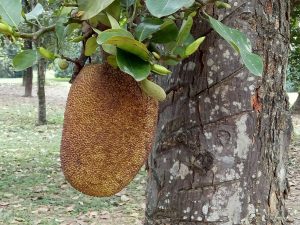
Main Attractions
● Zhanglang White Elephant Temple(章郎白象寺)
According to the record of Pattra-Leaf Scripture which treasured up in Zhanglang Temple, the White Elephant Temple has a 1365 years history, with an area of 4 acres. There is a Temple, a mook room, a pagoda, and a Scripture library with more than 100 Pattra-Leaf Scripture. The whole Temple building group reflect the unique art style of Bulang Ethnic building style.
● Ancient well(千年古井)
There is a ancient well outside the Zhanglang Village with thousands of year. According to legend, a disciple of Sakyamuni passed away the village, and the weather is too hot, the elephant was intolerable thirst, so it dig a well with its long nose. The interesting is that the well never dried-up all around the year.
● Bada Mountains(巴达山)
Speaking of Bada, the Bulang people consider it as “where the immortals left footprints” in their language. It’s a famous place among tea fans in China and abroad. In 1962, Yunnan Institution of Tea found an ancient wild tea tree over 1700 year old in virgin forest beside Hesong Village in Bada, experts and tea fans hand been visiting this place almost every year since then. Bada obtains most of wild tea trees in Xishuangbanna, the original tea trees grow in an area over 6000 acres. There are also large artificial cultivation tea [FS:Page]plantation in Bada, which distribute in villages like Zhanglang, Manmai, Manpi and Manpana.
●Bulang Eco Museum(布朗生态博物馆)
Bulang Eco Museum is the first Eco Museum of Bulang Nationality in China and the world. It is located in Zhanglang Village, the border of China and Burma. It is a typical Bulang Village with 1400 years of history. There are ancient Buddhist Temple, ancient tea garden and ancient Dragon Mountain Forest. The ancient culture, living and working styles, moral values, folk customs such as production, marriage, funeral, house construction, sacrifice, diet still remains in Zhanglang Village. The museum collects the daily necessities, repair some ancient buildings and educate the villagers to protect their traditional customs. The villagers in the eco museum are more important element of the museum than natural scenery and exhibitions.
Recommended Tours
2 Days Xishuangbanna Ethnic Villages Hiking Tour from Bada to Zhanglang
6 Days XishuangBanna Tea Mountain Hiking Tour to Bada, Zhanglang, Xiding and Nannuo Tea Mountain
6 Days XishuangBanna Tea Culture and Ethnic Villages Hiking Tour from Bada to Xiding
Nearby Attractions
Jingzhen Octagonal Pavilion (Chinese name: 景真八角亭), an famous ancient Buddhism architecture in China, is one of the most important cultural relics in Xishuangbanna. Located in the Jingzhen Village, this pavilion is called Octagonal Pavilion which means a place to hold the holy religious ceremony.
Best Time to Visit
Belonging to tropical rainforest climate, Xishuangbanna’s dry season is from November to April the next year and rainy season is from May to October. It has long summer and no winter. With cool and pleasant four seasons, the best time for traveling Xishuangbanna is from October to April the next year.
Useful Travel Tips
●It is better to prepare some mosquito products and sun block in case of insects and sunlight.
●Respect the local customs of Bulang.
●Respect their belief to Buddhism.
●It is better to take T-shirt, short and slippers becauce it is too hot in Xishuangbanna.
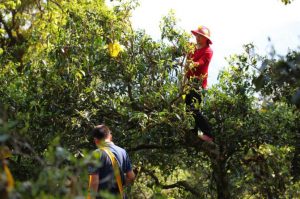
Nannuo Tea Mountain
Nannuo Mountain is famous in China and abroad as the home of the “King of Tea Tree,” a human cultivated 800+ year old tree. Fine tea tree varieties and superior natural conditions produce outstanding Nannuo Mountain tea products. Nannuo Mountain Peacock tea is a 400 gram fresh Pu-er cake. It possesses a green, glossy luster and has leaves and buds that are plump, strong, and tender. The strips of tea unfold with prominent fine hair. When brewed, the tea liquor is a bright golden yellow with a strong, but mellow and refreshing flavor. It has a sharp kougan (feeling in the mouth) and stimulates salivation. The tea has strong and distinctive aroma.
Here, travelers can feel the emotion of King of Tea Tree, enjoy the favorable flavor of tea plantation, step into the Hani Villages and experience the local custom and taste the natural inviting potherbs and wild fruits.
Why is Nannuo Tea Mountain so special?
Nannuo Mountain is famous in China and abroad as the home of the “King of Tea Tree,” a human cultivated 800+ year old tree. Fine tea tree varieties and superior natural conditions produce outstanding Nannuo Mountain tea products. Puer Tea is mainly made of tea of Nannuo Mountain. Nannuo Tea Mountain become famous with the selling of Puer Tea at home and abroad.
Menghai tea factory has released this Peacock series of single-estate tea mountains since 2001. They represent some of Menghai Tea Factory’s most sought after teas and are produced in very limited quantities.
Ethnic Villages in Nannuo Mountain
Villages in Nannuo Mountain consist of Banpo Laozhai Village(半坡老寨), Duoyizhai Village(南糯山多依寨村), Guniang Village(姑娘寨), Yakou Xinzhai Village(丫口新寨), Laozhai Village(老寨), Shitouzhai Village(石头寨),Zhulincun Village(竹林村寨) ,Xiangyang Village(向阳寨) and Shuihe Village(水河寨).
Where is Nannuo Tea Mountain?
It is located in the eastern portion of Menghai County of Yunnan Province’s Xishuangbanna Prefecture. It has an average elevation of 1400 meters above sea level. The entire mountain is covered in shaded forests of green bamboo and other trees. Ecological conditions are excellent. Nannuo Mountain tea trees are large-leaf arbor-type.
Nannuo Mountain Travel Guide
Nannuo Mountain Village is located in the Gelanghe and Hani Autonomous Township of Menghai County. It is the eastern gateway to Menghai and the starting point of the “Seven Sons Cake” tea culture tourism route. Known for its titles such as “Global First Ancient Tea Village,” “First Ancient Tea Mountain,” and “Place of Climate Transition,” Nannuo Mountain enjoys a pleasant climate with an average annual temperature of 17.9°C. The area is renowned for its beautiful ecological environment, rich ancient tea tree resources, including 800-year-old cultivated tea trees and 12,000 acres of contiguous ancient tea gardens. It also features the historic Menghai Tea Factory No. 1, which was the first mechanized tea processing plant in Yunnan, established in 1938. The village maintains a rich ethnic culture, with well-preserved Hani ethnic costumes, traditional dwellings, indigenous songs and dances, and distinctive festivals. The long history of tea cultivation and processing has resulted in a deep and rich Hani tea culture.
First Stop: Hani Cultural Park
Hani Cultural Park is located 24 kilometers from Jinghong on the Menghai highway. It is a convenient place to explore and learn about Hani culture. The park includes the Hani Ethnic Museum, traditional Hani dwellings, ethnic tourism, handcraft displays, and specialty Hani restaurants. Visitors can learn about Hani clothing, tea culture, weaving techniques, farming culture, and daily life.
Second Stop: Nannuo Mountain Viewing Platform
The Nannuo Mountain Viewing Platform is located along the route between Gu Niang Village and Duo Yi Village. Climbing the platform in the morning dew offers a view of the city of Jinghong with its distant lights and the nearby peaceful Hani villages. After rain or in the early morning, you can observe the white mist rising from the valleys, sometimes light and ethereal, sometimes surging and turbulent, like waves rolling through the mountains. Amidst the sea of clouds, the Hani villages appear faintly, resembling islands in the clouds, creating a beautiful, otherworldly scene.
Third Stop: 800-Year-Old Tea King Tree
The Tea King Tree is located in the Banpo Laozhai village group. Follow the stone-paved walkway to the Banpo Laozhai Ancient Tea Garden. Along the way, you will see rows of ancient tea trees with sunlight casting dappled beams. The wind, bird calls, and insect chirps create a harmonious background. Proceed to find the 800-year-old cultivated tea tree standing majestically on the hillside. This ancient tree, having endured centuries, remains lush and vibrant, showcasing unique vitality and beauty. A small pavilion nearby offers a place to sit with locals, enjoy tea, and listen to the soothing sounds of flowing water.
Fourth Stop: Heiniu Ancient Tea Garden
From the Banpo Laozhai Tea King Tree walkway, you can reach various village clusters such as Yako Laozhai, Yako Xinzai, and Duo Yi Village. At nearby Hani restaurants, you can try traditional Hani dishes with “sour, spicy, and fresh” flavors, such as delicate chicken porridge, aromatic smoked dried meat, mountain-style salt and pepper fish, and tea-stirred eggs. Climbing to the highest peak of Duo Yi Village, Heiniu Ancient Tea Garden, you can join the Hani people in picking tea, feel the natural power of growth with your fingers, and personally experience tea processing techniques like roasting and drying. Enjoy the fresh tea aroma and the refreshing feeling it brings.
Fifth Stop: Menghai Tea Factory No. 1 Old Site
The Menghai Tea Factory No. 1, founded in 1938, is the first mechanized tea processing plant in Yunnan. The old site, located in Shitou Xinzai, features a design that blends Chinese and Western styles, with a solid stone foundation and thick walls that record historical changes. It documents the tea cultivation and processing techniques of the Hani people and their deep connection with tea.
Sixth Stop: Semi-Mountain Hotels and Guesthouses
Nannuo Mountain Village emphasizes the integration of tea culture and tourism, transforming villages into scenic spots, tea gardens into attractions, and farmhouses into guest accommodations. The area has developed several semi-mountain hotels and guesthouses, such as the Jianglu and Nanshan Hidden, where you can enjoy serene nights away from the city’s hustle and bustle. Staying in these mountain lodges surrounded by tea forests, you can wake up to mountain views, sleep under the stars, watch the sea of clouds, and enjoy the picturesque sunrise. Experience the leisurely pleasure of sitting by the fire and chatting with the Hani people.
How to Get to Nannuo Tea Mountain?
Nannuo Tea is located in Gelanghe Township of Menghai County, so travelers need to get to Menghai at first and change bus or drive to Nannuo Tea Mountain.
Long-Distance Bus is an important way getting to Menghai County, which could be accessible from Kunming, Jinghong, etc. Here we list some of the bus information for your reference.
| Route | Departure Station | Arrival Station | Departure Time |
| Kunming-Menghai | Kunming South Passenger Station(南部客运站) | Menghai Passenger Station(勐海客运站) | 11:00, 17:30; 20:00 |
| Kunming-Menghai | Kunming High-speed Rail South Passenger Center(昆明高铁南客运中心) | Menghai Passenger Station(勐海客运站) | 11:30, 16:00, 20:30, 21:30, 22:00, 22:40 |
| Kunming-Menghai | Kunming North Passenger Station(北部客运站) | Menghai Passenger Station(勐海客运站) | 21:00 |
| Jinghong-Menghai | Jinghong Passenger Station(景洪客运站) | Menghai Passenger Station(勐海客运站) | 07:00, 07:20, 08:10, 08:50, 09:10, 09:30, 10:00, 13:40 |
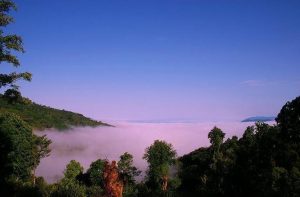
History of Nannuo Tea Mountain
Nannuo means “bamboo paste” in the Dai language. During ancient times, Nannuo Mountain was primarily inhabited by ethnic Hani people.When they had too many bamboo shoots to eat, they made the leftovers into a paste. This paste was presented to the village chieftains every year. The mountain was subsequently named Nannuo Mountain.
Long times ago, it was not convenient to transfer in Nannuo Mountain because of the dense forest. The horse was the only tool to send the tea out the mountain. Due to the high-quality of tea of Nannuo Mountain, a lot of horse caravans came into villages and took the tea to Simao, Menghai, Mengla, even the countries of south Asian. Nannuo Tea Mountain is the best production place for Puer Tea. Nannuo Tea Mountain becomes more and more popular.
Other Information about Nannuo Mountain
Xishuangbanna Nannuo Tea Planting Area
Nannuo Tea Mountain is located in Gelanghe Township of Menghai County and is mainly inhabited by ethnic Hani people. It lies 22km from Jinghong and 20km from Menghai. During the 1920’s, the Republic of China government established Yunnan’s earliest tea industry testing ground at Nannuo Mountain. The Nannuo Mountain area contains vast tea growing areas and possesses a long history of growing tea. Its history of tea cultivation can be traced back to the Tang dynasty (618-920AD). It is also the oldest test-bed of industrialization in Xishuangbanna. Today there are still more than 10,000mu of remaining Nannuo Mountain old tea gardens. Combined with the past several decades of development in tea cultivation, this has made Nannuo an important source of raw tea material for the Menghai area.
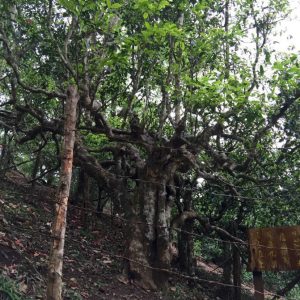
Climate of Nannuo Tea Mountain
Nannuo Mountain has a mild climate with a yearly average temperature of 18.7°C. Lying at elevations between 800 to 1500m, it serves to divide the climates of Menghai and Jinghong. Temperatures range from 3°C to 33.5°C. It is said to possess: “winters without brutal cold, and summers without extreme heat. There are many foggy days, but ample amounts of warm sun. Rainfall is plentiful.” Average relative humidity is 78%.There are an average 100 to 150 foggy days per year, which makes Nannuo a fine example of the saying “High, foggy mountains produce famous tea.”
Aini People
Gelanghe is a Hani Ethnic Township, which has a meaning of happiness and good fortune. Aini people, a tribe of Hani minority, have lived here for long time. They have no written system, so they carry on the ethnic history, legend and folk songs from mouth to mouth.
Recommended Tours
1 Day XishuangBanna Nannuo Tea Mountain and Aini Ethnic Village Hiking Tour
3 Days XishuangBanna Tea Culture Tour to Yiwu and Nannuo Tea Mountains
6 Days XishuangBanna Tea Mountain Hiking Tour to Bada, Zhanglang, Xiding and Nannuo Tea Mountain
Nearby Attraction
Jingzhen Octagonal Pavilion (Chinese name: 景真八角亭), an famous ancient Buddhism architecture in China, is one of the most important cultural relics in Xishuangbanna. Located in the Jingzhen Village, this pavilion is called Octagonal Pavilion which means a place to hold the holy religious ceremony.
Best Time to Visit Nannuo Mountain
Belonging to tropical rainforest climate, Xishuangbanna’s dry season is from November to April the next year and rainy season is from May to October. With annual average temperature of 21c, it has long summer and no winter. With cool and pleasant four seasons, the best time for traveling Xishuangbanna is from October to April the next year.
Useful Travel Tips
●It is better to prepare some mosquito products and sun block in case of insects and sunlight.
●It is better to take T-shirt, short and slippers becauce it is too hot in Xishuangbanna.
●Respect the local customs of Aini people and other minorities.
●Take care of yourself when climbing the Nannuo Mountain.
Chinese Name: 会泽念湖
English Name: Nianhu Lake in Huize County, Qujing
Chinese Name:师宗县菌子山
English Name: Junzi Mountain in Shizong County, Qujing
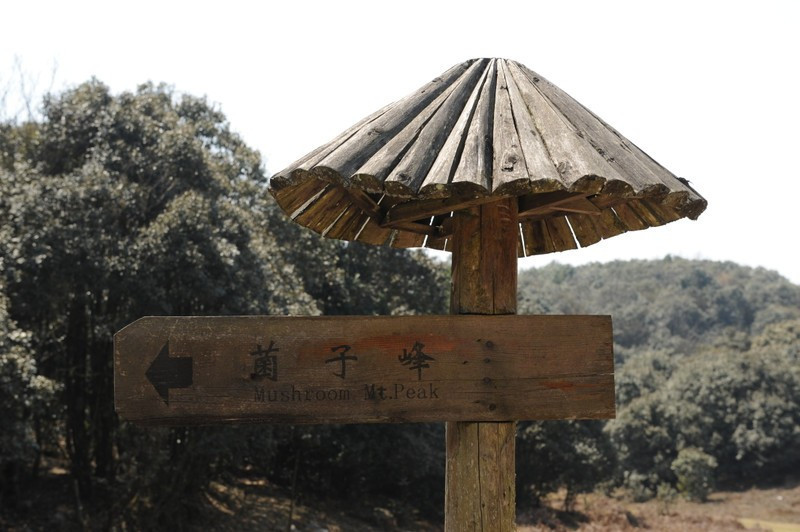
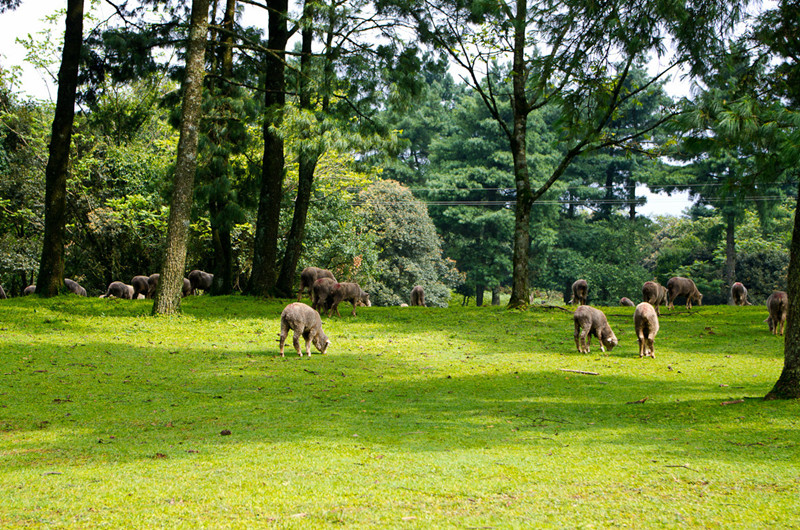
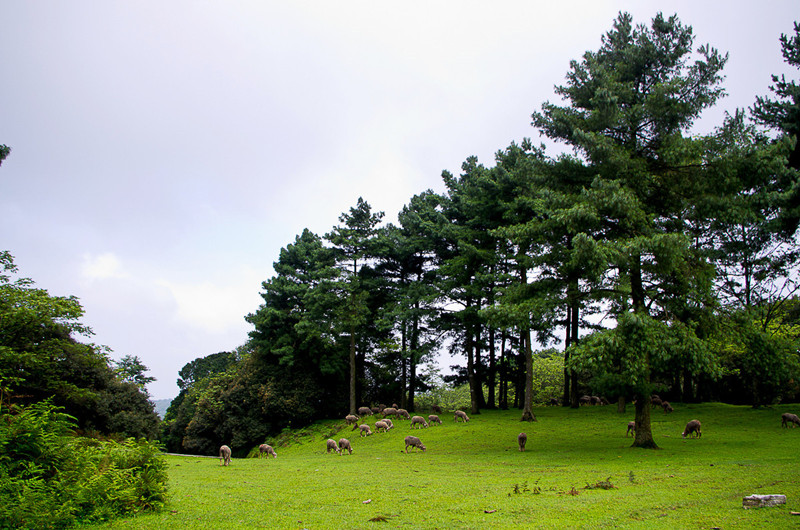
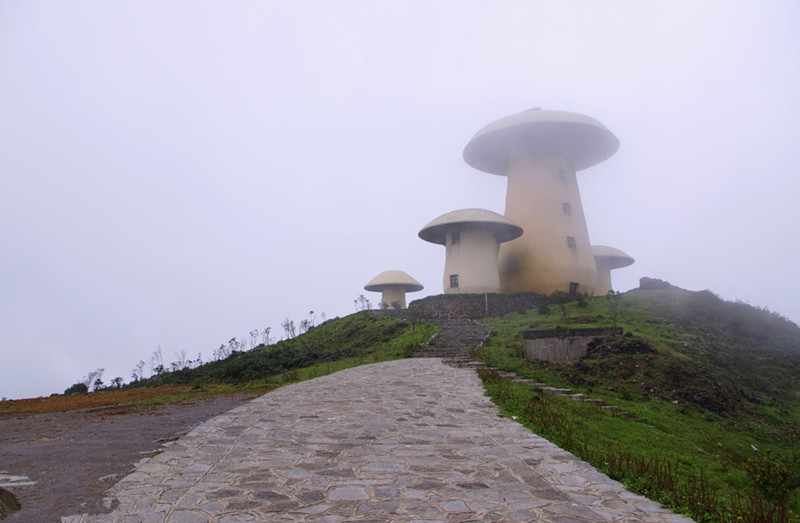
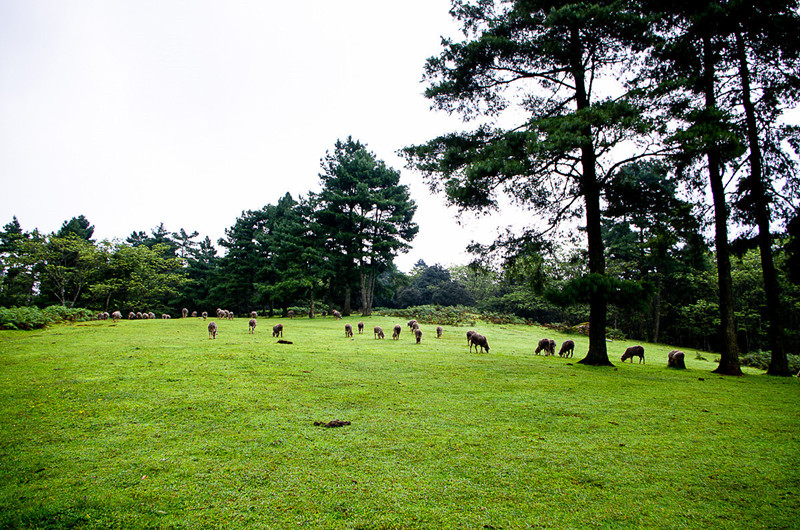
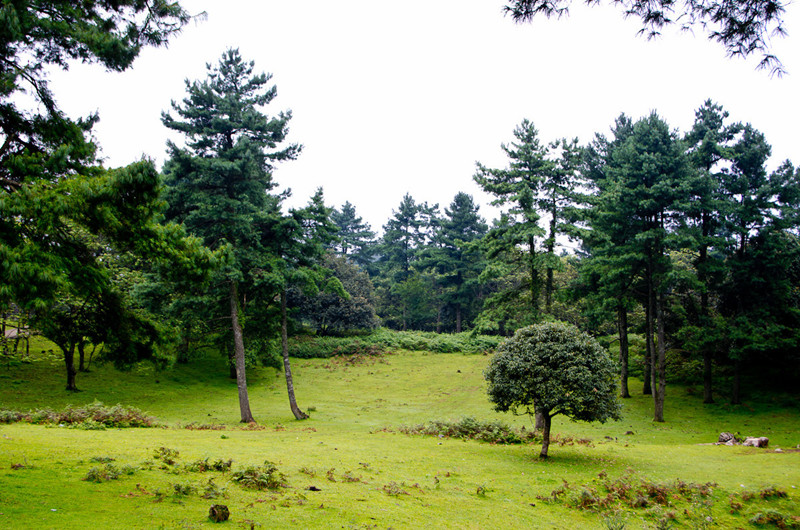
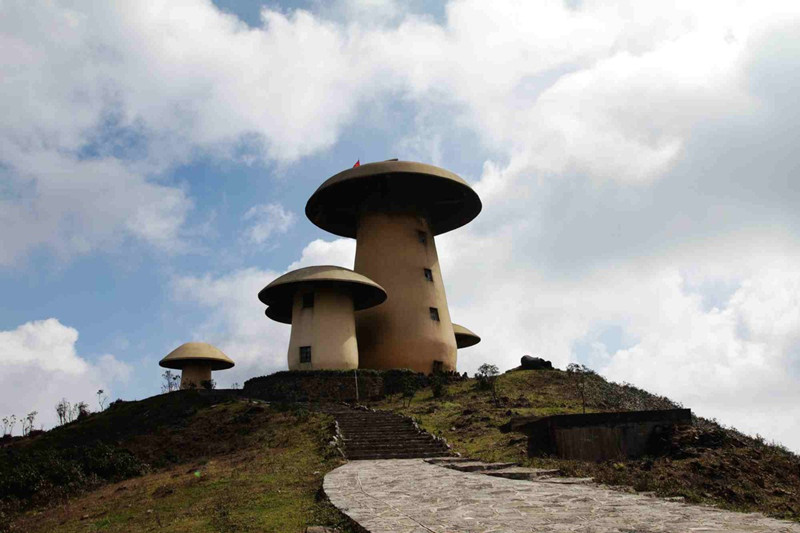
Location:
Chinese Name: 会泽古城
English Name: Huize Ancient Town, Qujing
可以直接去看百度百科
http://baike.baidu.com/link?url=pqEpevzLRcEe30_WVlnhEZ5fEQIhSxLvFyJX6c5_6zT5op7OO93JndGFUy07joO6xmwW6BMuLVOB_Wm05waFvdcKSJbq6mVGqEwmz41Goa-InmzDAG4i-ZYUDlF7rWKf
会泽古城,位于云南省东北部,曲靖市西北部,地处三省五州(市)接壤地带,距省会昆明市区205千米,距曲靖市区187千米。会泽历史悠久,是历史上云南最早设置的四个郡县之一。会泽古城建于清雍正九年(1731年),由时任东川知府崔乃镛主持建造。会泽古城有馆藏文物8000余件,其中国家级文物67件。会泽会馆林立、寺庙众多,名居民宅独具特色,被誉为“明清古建筑博物馆”。明清时期曾建有会馆、寺庙108座,现存会馆、寺庙38座,特色民居65处。以八大会馆为代表的会泽会馆群被列为国家重点文物保护单位。2013年5月22日,国务院批复同意会泽县列为国家历史文化名城。
历史沿革
会泽古城建于清雍正九年(1731年),由时任东川知府崔乃镛主持建造。
雍正十年(1732年)十月东川府石城竣工,共用工37万个,支银31425两。石城周长214丈,南北141.6丈,城墙高厚各1.4丈,设炮台八座,垛口1213个,四门城楼各两层,高2.7丈。
雍正十一年(1733年)东川7.5级大地震,部分损坏,后修复。
道光二十四年(1844年),城墙出现部分坍塌,知府李德生、知县黄梦菊发动官绅士民捐银16366两重修,城墙加高三尺,达2.1丈,垛口达到1372个。
光绪六年(1880年),代理知县秦述先禀请重修了年久朽坏的四门城楼。
同治元年(1862年)10月,太平天国翼王石达开率西征军进入东川(今会泽)境内,曾派小股部队攻打东川府城。由于城防坚固,太平军两次攻打未克,遂主动放弃府城,向西北的娜姑进发。东川知府黎兴德、参将杨盛宗、会泽知县靖华壁乘隙率清兵出城追击太平军,双方在崇礼乡(今白雾街)展开鏖战。
1935年5月2日,长征中的中国工农红军九军团在军团长罗炳辉和政委何长工率领下进驻会泽,九军团部和参谋人员立即从东门入城,登上东北角钟楼指挥队伍,红军战士搭起云梯从西门攻入城内。
1949年4月9日,云南人民讨蒋自卫军永焜支队兵临会泽城下,在炮火的掩护下,利用缴获的TNT炸药爆破北城门,攻入县城。
2013年5月,会泽古城被列为国家历史文化名城。

地质地貌
会泽地处滇东北高原,乌蒙山主峰地段。山高谷深,沟壑纵横。山川相间排列,山区、河谷条块分布。地势西高东低,南起北伏,由西向东呈阶梯状递减。会泽的地貌景观主要有三种类型:以山地地貌为主,次为盆地地貌,部分为冰川地貌。
气候特点
会泽属典型的温带高原季风气候,四季不明,夏无酷暑,冬季冷寒,干湿 分明。会泽立体气候特点突出,从南亚热带至寒温带气候均有分布。
会泽平均海拔2200米以上,高原空气稀薄,辐射波短,日照时间长。年平均晴日225天,年日照2100小时,年平均气温12.7℃。春季升温快,秋季降温快。
建筑布局
古城布局
会泽古城不大,最初是土城,为首任知府王永玺所建,后于雍正年间知府崔乃镛历时一年半建为石城,城周长2374.3米,宽4.6米,高5米。老城十字街是古城的中心,一横一纵两条街道交会构成个“十”字,加上方形的城墙,整个古城其实就是个“田”字形。
会泽现存古城是清代所建,距今约有300多年的历史,保存着各类珍贵的文物古迹、比较完整的城市格局和部分历史街区。城区范围北到义通河、南至钟屏街、东到翠屏街、西至京运大街,面积约0.95平方公里。
三区是在中心城区周围3个古代筑城的遗址,分别为:城西北的水城遗址、城西南的土府遗址、城东的土城遗址。
二街是会泽古城内最具代表性的历史文化街区,头、二、三道巷历史文化街区以及十字街历史文化街区。
十九点是指四川会馆、陕西会馆、江西会馆(万寿宫)、湖广会馆等19座古建筑。
建筑群落
会泽会馆群
据统计,会泽有馆藏文物8000余件,其中国家级文物67件。会泽会馆林立、寺庙众多,名居民宅独具特色,被誉为“明清古建筑博物馆”。明清时期曾建有会馆、寺庙108座,现存会馆、寺庙38座,特色民居65处。以八大会馆为代表的会泽会馆群被列为国家重点文物保护单位。
乾隆时期,清政府已经把铜矿开采的重点转移到国内,东川会泽一带的铜矿得到了极大的开发,铜厂在最鼎盛时期达到33个。
会泽铜矿采冶规模空前的兴旺发展,吸引了赣、浙、桂、川、黔等地的官商、富贾、工匠、平民拥入东川府。这些外来客为了自身的经济利益和安全,“同乡结党”,兴建同乡会馆;“同行结会”,设立行业庙会;“同教联宗”,建立宗教寺庙。会泽共有各省会馆、寺庙100余座。
古城民居
会泽民居可分为联排式和合院式两类,东西两公里长的东内、外街、西内、外街和南北一市里长的南北街、外街,多为联排式民居;头道巷、二道巷、三道巷及丰乐街,则是合院民居集中之地。县城的合院式民居已远不只是满足建筑作为“庇护所”的需求,更多地是体现了房主一种自我价值的满足感,所以类型各异,风格不同,其中有二进院、三进院、一颗印、重堂式、三间两耳式、三坊一照壁、四合五天井、走马串阁楼等,表现出一种相似而非相同的特点。
民居几乎都有即在屋脊上面两段瓦沟上用板瓦搭成拱形,其头部则为一高翘起的筒瓦,像猫的两只眼睛,虎视眈眈地注视着前方的两个采光通风洞。当地人称为“猫洞”,据说它除了采光通风外,实则是起辟邪的作用。除了猫洞,还有“猫拱墙”,即房屋的两侧,为一段圆弧形的山墙,类似于两只弓着背的猫。圆弧形的山墙受力较均匀,地震时不易倒塌,最主要的是加入隔壁邻居失火,猫拱墙可以隔断相邻的火势,起到封墙火的作用。这些细微的建筑符号,表征了会泽多元文化交融的情况。
主要景点
文化古迹
湖广会馆
湖广会馆俗称寿佛寺、东岳宫,系湖广籍同乡在会泽所建会馆,云南省重点文物保护单位。[10]
湖广会馆座落于县城东北面宝善街,建于明末清初,门楼戏台、前殿、中殿、后殿及东西偏殿两厢书楼、花园规整地排列在一中轴线上,占地面积8474.4平方米,建筑面积3127.6平方米,整个建筑气势恢宏,气宇非凡,《禹王宫碑》载:“殿宇庄严,久为楚表”。
江西会馆
江西会馆,俗称江西庙
、万寿官,是江西人在会泽县城建的会馆,位于县城北面江西街的中段,建于清康熙五十年(1711年),占地7545.92平方米,建筑面积2594.74平方米,整个建筑坐南朝北,沿中轴线作纵深布局,为三进两跨院,建有门楼戏台、正殿、后殿。东侧为小花园,西侧是小戏台。始建于清康熙五十年(1711年),雍正八年(1730)毁于兵燹,乾隆二十七年(1762)重建。2006年5月,被国务院公布为全国第六批重点文物保护单位。
唐继尧故居
唐继尧故居座落在县城北内街三道巷14号,占地面积851.1平方米,属会泽清代中晚期传统民居、封闭式四合院建筑。始建于清同治六年(1867),清光绪十五年(1889)唐继尧的父亲唐学曾购置此宅院。
会泽文庙
会泽文庙位于会泽县古城街道堂琅社区七组灵壁路南侧会泽一中校园内。占地面积约20000平方米。始建于清康熙六十年(1721),系东川知府任俊舫首倡并捐资兴建。
水城古汉墓
1997年,云南省文物考古研究所派员会同曲靖地区文物管理业务人员经过实地踏勘,2002年1月,开始了大规模的勘探和发掘工作。这一古墓群东西长1公里余,南北宽300—500米。
墓葬中出土器物编号338个,出土器物近400件。出土器物以陶器为主,另有部分青铜器、铁器、银器、鎏金饰品及玛瑙饰品等。陶器包括有罐、釜、盆、甑、豆、碗、壶、仓、灶、井及房屋模型等;铜器主要有:洗、釜、壶、甑、碗、镜、灯、带钩及钱币等;铁器主要有剑、削、釜、三角架等;鎏金铜饰品有铜泡、泡钉、壁、墫等;银器主要为银手镯;玛瑙饰品有珠、管等。发掘出土的文物与“夜郎文化”有十分密切的关系。
自然景观
金钟山
金钟山位于云南会泽县城南面,与县城紧紧相连。因其状如钟而得名,也称“七曲名山”。金钟山上始建于清雍正5年(1727年)、于乾隆56年(1791年)重修的文昌宫,与位于公园西侧马鞍山上的文笔塔、华宜寨的魁阁呈三角对立、相互辉映的“文运”之势。
历史文化
民俗文化
会泽海腔
会泽海腔有着较为固定的曲调,海腔历史悠久,代代相传,词可以适时翻新更换,但所形成的曲调却固定了下来,成了“凝固的音乐”,调子高,有很大的艺术难度。
堂琅古乐
会泽堂琅古乐,又名洞经音乐。“洞经”系道家经典的统称,洞经音乐用于道教礼乐活动,唐宋时期盛行中原,明清之际流传各地,官绅文人争相谈演,晚清以后,逐渐失传。传到会泽后,受到了当地文人士子的欢迎,并进行了创造性的融合,发展成风格独具的堂琅古乐,它既完整保持着洞经音乐的庄重、古朴、静淡、超然的意境,又吸纳了宫廷音乐的典雅,同时糅入了江南一带汉曲丝竹乐韵和当地的滇剧及俚俗音乐,反映了会泽历史文化名城多元文化的内涵特点。
民族节日
二月二
二月二这天,在会泽乃至滇东北地区有为小孩剃长发、大人剃个龙抬头的习俗。据说,男人们这天理了发,便会像龙抬了头,日后会兴旺发达,好运连连。每到农历二月二,会泽县城周围十里八乡的大人小孩就会走出户外上金钟山逛庙会,剃头发,祈求安康。
古城特产
会泽斑铜
斑铜的制作工艺有别于青铜器,这种人工多种金属合成的制作工艺浇铸成型后,在表面形成不同规则的自然晶斑,流光溢彩。《滇海虞衡志》记载:“锤造炉瓶成冰形,而斑斓者为斑铜”,斑铜是会泽独特的一种民间手工艺,采用含铜量在90%以上的自然铜为原材料,经过手工艺人手工锻打之后,使得其中含有的其他金属元素“再结晶”而产生斑驳的金属纹。然后再通过一些特殊方法的处理之后,把这些金属斑显现出来。采用传统的手工锻打的生产方式现在称之为“生斑”。
铁胆石
会泽铁胆石有千奇百怪的天然造型、变化莫测的金属图纹、富丽堂皇的
金属光泽,总让人不得不惊叹于大自然的鬼斧神工,倍受奇石收藏界的关注和宠爱。在第四届中国成都(国际)奇石博览会暨首届中国西部古玩珠宝、根艺、书画鉴定展销会上,会泽出品的9件铁胆石获大奖,其中驾车乡张小友的铁胆石作品“佛娃”获得金奖。
奇彩土豆
薯型小巧、色泽绚丽、营养丰富、水份少、淀粉高、味道可口,是无污染的绿色食品,被誉为“薯中精品”。
特色美食
羊八碗
羊八碗以会泽优质山竭羊为主要原料,采用蒸、煮、炒、炸、炖、焖、溜、滑等多种烹饪技法,制作的精美羊八碗系列美食:峰浪望月、羊干巴、葱芫杂碎、黄焖羊肉、红烧羊肉、香葱沫肉、四季水煮、糊辣炒肚等名菜。
稀豆粉
稀豆粉采用优质豌豆去壳,经水泡、磨浆、过滤后煮沸,稀稠适中,配以荞丝、油条,佐以芝麻油、花椒油、姜泥、蒜泥、葱丝等调料,味道鲜美。
虹鳟鱼
虹鳟鱼被誉为“水中人参”,头小,骨少、肉厚,肉质鲜嫩,味美带有海味,无腥,蛋白质和脂肪含量高,胆固醇几乎为零。鱼肉生吃,鱼皮油炸,鱼头清炖,鱼骨清蒸,生鱼片蘸红醋或绿芥末吃尤其美味。
燕麦粑粑
燕麦粑粑是用燕麦面粉精制而成。
会泽炸洋芋
会泽炸洋芋脆皮酥心满口香,麻辣适中调料齐。
会泽舂饵块
会泽舂饵块,饵块是云南名特小吃之一,烹饪方法有烤、炒、煮、卤、炸等,风味各异。西汉时史游所著的《急就篇》有“饼饵麦饭甘豆羹”、“溲米面蒸之则为饵”的记载。
都督汤
都督汤,用洋芋泥、米汤、食用油等制成,味道鲜美,营养丰富,是唐继尧当年最喜爱吃的一道名菜。
荞面汤
荞面汤,用苦荞面粉和优质酸菜加工而成。
豆花米线
豆花米线以米线、豆花为主,配以少许豆芽、韭菜和特制汤料,佐以芫荽、葱花、花椒油、辣椒油、芝麻油、肉末、酱油和醋。
景点门票
开放时间
开放时间:全天开放
Laodabao and ‘Happy Lahu’
Laodabao Village(老达保寨), located in the southeast of Lincang County, is 42KM from the county. It is a typical Lahu Village with all the 114 families/473 villagers are Lahu People.
Laodabao Village is one of the villages that have inherited the Lahu’s Creation Epic”Mupa Mipa”(《牡帕密帕》) which has been selected as the first batch of national intangible cultural heritage protection list in 2006. As the land of singing and dancing, it is famouse for cappella with rich harmonies and being the hometown of ‘Happy Lahu’. Villagers are very welcoming and will show you their gracious hospttality with songs and drinks once you step into the village.
People in Laodabao can sing and dance, over 200 of them could act on stage. Lahu music and dance performed in Laodabao are of passion and creativeness. Boys around 13 or 14 can play Sheng and perform Lusheng Dance, girls can sing and perform Bai Dance. Singing skills in Laodabao include traditional singing and multi-chorus Christian songs sang in Lahu language. Although there is no formal vocal training, some of the villagers could not even read opern, they can sing in 4 chorus, in the past the polyphonic are sang only in the church, not to be explored for a long time until 2004 national and folk traditional culture survey.
Ya’er Folk Art Troupe’s performances are of traditional Lahu cultural characteristics, as well as the inclusiveness to absorb foreign and contemporary culture. Since 2005, they’ve given performances in different scales of shows.
What to see in Laodabao Village
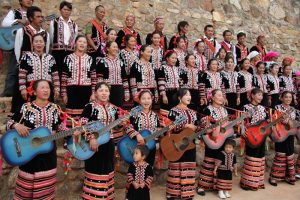
Laodabao Village, with well-preserved primitive sceneries, is very natural and beautiful. You can peer at their ethnic customs and profound history from their traditional pole and column buildings in the village since it is the village which has preserved the most intact Lahu’s traditional cultures throughout the time. Beyond the beautiful sceneries, ethnic customs and historical cultures, the biggest highlight here is the local people – they can get you away from the daily weariness and troubles by their happy songs and dances, so that to fully appreciate their daily lives and happiness.
The song ‘Happy Lahu’ , with simple melody and light rhythm, is very easy to learn, you can try to sing and dance with local people. Lahu People, no mater men and women, young and old, can both sing and dance very well, they are very good at Lusheng Dance, Baiwu Dance and cappella with rich harmonies while the most stand-out is singing with a guita. Approximately 80% of the villagers can play the guita, the oldest player is over 70 years old while the youngest one is just little kids. Although, they have never been trained, most of them hardly know nothing about the musical notation, they have created many popular songs in the virtue of their enthusiasm towards music and their daily lives. They have wrote nearly 300 songs and the most popular ones include ‘Happy Luhu'(快乐拉祜),’Truly Love You'(真心爱你) and ‘Happy New Year'(新年在一起), etc. The ‘Happy Luhu’ once helped them gain the reputation of ‘Happy Lahu win the world with only one guita’.
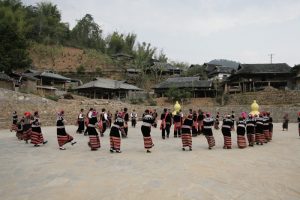
Past, Now and Future
However, Laodabao is a typical remote and poor mountain village in the past. With badly infrustructure, villagers used to walk to contact with the outside, get water from the well, light the nights by oil lamp and yell to exchange messages. Under such a poor production and living condition, the evarage annual income was only 1715 RMB.
In recent years, in the advantage of the abundant Lahu ethnic cultures, Lancang County has designed a characteristic road for Ladaoba-to construct a tourist ethnic village. As one of the villages that have inherited the Lahu’s Creation Epic”Mupa Mipa”(《牡帕密帕》) and the most intact Lahu cultures, most of the villagers are good at singing and dancing, among them includes 6 inheritors of traditional and ethnic cultures. With all these advantages, villagers have established sevaral art troupe such as ‘Laodabao Art Troupe'(老达保雅厄艺术团), ‘Five Bros'(达保五兄弟) and ‘Dabao Sisters'(达保姐妹). They have been invited to perform in many cities at home and abroad, take part in many famous TV Shows including “Meili 12″(魅力12),”Xing Guang Da Dao”(星光大道),”Minge China”(民歌 中国),”I Am Going to the Sping Festival Gala”(我要上春晚) and “Dream Chorus” on China Centrel Television(CCTV), and also join many well-known folk and tourism festivals. With all these efforts, they have brought the Lahu culture to the whole world and make their hometown a popular tourist destination.
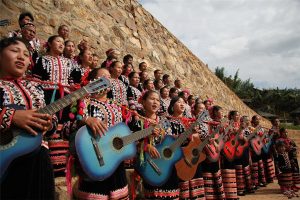
In 2003, Ladabao has founded its own perfprmance art company – Lancang Laodabao Happy Lahu Performance Limited Company(澜沧老达保快乐拉祜演艺有限公司). It is the first performance company that founded by local villagers in Puer. Over 200 villagers are performing for the company, and when there is no performance, they spend their time doing farm work. Up to now, over 600 performances have brought an income of 3.32 million yuan and villagers have shared a bonas of 2.26 million yuan, the total tourism revenue reaches 5 million yuan. At the same time, Laodabao has been listed as the core area of the ‘HALEJA Country Music Town’ which was built by the Puer municiple government with a total invest of 5.03 billion yuan. With promising prospect, we believe that Laodabao will get better and better in the future.
Lahu People’s Hand Washing Ceremony
The Hand Washing Ceremony is a traditional greeting of the Lahu people (拉祜族), an ethnic group that has come “out of the gourd.” Whenever a distinguished guest enters a Lahu village or home, the women of the village greet the guest by washing their hands with clean water from a gourd, symbolizing respect and welcome.
![Hand washing ceremony image]
Visit the Heritage Museum and Intangible Cultural Workshops
Along the village roads, visitors can explore the Spinning Top Workshop, Lusheng Workshop, Wood Carving Workshop, and Weaving Workshop, experiencing the traditional Lahu village architecture and lifestyle. Here, you will also discover the unique craftsmanship and daily life of the Lahu people.
![Workshops image]
The Heritage Museum (传承馆) was built in 2010 to preserve traditional farming tools, ethnic culture books, and other artifacts. This museum plays a crucial role in protecting the roots and soul of Lahu culture and records the history of Old Dabo (老达保). The museum underwent a comprehensive renovation in 2024, offering visitors a refreshed sensory experience.
![Museum image]
Folk Experience
Baba (粑粑) represents unity and is an essential part of Lahu culture. To prepare it, glutinous rice is soaked in water for 2-8 hours. Afterward, it is steamed for about 35 minutes. Black and white sesame seeds are roasted and ground, then mixed with the steamed rice, which is pounded into a smooth texture and shaped into small cakes.
![Baba image]
Check-in at the Xiecheng Holiday Farm
The Xiecheng Holiday Farm (携程度假农庄) is integrated with a tea garden and trendy vacation homes. The farm offers a comprehensive range of facilities, including a coffee area, camping, and barbecue spots. Guests can also enjoy traditional Lahu dance and songs around a bonfire, ancient tea roasting methods, and ethnic costume photoshoots, blending modern elements with Lahu culture to enhance the tourist experience.
![Xiecheng Farm image]
Ethnic Song and Dance Performances
The Old Dabo Lahu Ethnic Ecological Live Performance showcases multi-part acapella songs such as “Hunting Song” (打猎歌) and “Four Seasons Tune” (四季调), which bring visitors closer to Lahu traditions. Over time, these songs have evolved to include popular songs like “Tea Respect Song” (敬茶歌), “Wedding Vows” (婚誓), “Happy Lahu” (快乐拉祜), “Reluctantly Leaving” (实在舍不得), and “I Truly Love You” (真心爱你), which are widely sung. The Lahu women’s traditional dance “Bai Dance” (摆舞) debuted at the 2022 Chinese New Year Gala, while the Lahu men’s dance “Lusheng Dance” (芦笙舞) is recognized as a national intangible cultural heritage.
![Performance image]
Exhibition and Sale of Ethnic Products
The area also hosts an exhibition and sale of Lahu silk weaving, ethnic costumes, bags, traditional handicrafts, wild honey, wood carvings, and ecological tea. This exhibition allows the continuation of traditions and introduces the local ethnic characteristics, culture, and industrial resources to visitors.
![Ethnic products image]
Walking on the Water Scenic Path
The Water Scenic Path (水景观栈道) is located next to the entrance of Old Dabo Village. It features beautiful landscapes where water and nature merge. The 3-kilometer path leads visitors to the highest point, where they can overlook the entire village of Old Dabo.
![Scenic Path image]
Food Square
The Food Square (美食小广场) offers a variety of local delicacies from the Lahu, Dai, and Hani (哈尼族) ethnic groups. You can try over ten types of snacks, such as lemon jelly, smashed chicken feet, grilled skewers, sticky rice, and small pot rice noodles. The flavors are tangy, spicy, and delicious.
![Food Square image]
Dining in Dabo (达保)
- Dabo Naluo Specialty Restaurant, located next to the Old Dabo scenic area, Li Naluo, 18724889195
- Dabo Ozhage Restaurant, within the Old Dabo scenic area, Zhou Gaixiu, 13759039775
- Dabo Farmhouse, beside the Old Dabo scenic area, Wang Jinyan, 15125577324
- Na’er Homestay, next to the Old Dabo scenic water path, Peng Na’er, 15008818456
- Namo Ocuoge Guesthouse, within the Old Dabo scenic area, Li Xiuzhen, 15125584480
- Lancang Ocuo Restaurant, near the Old Dabo scenic entrance, Zhang Zhanu, 18164634088
- Old Dabo Café, within the Old Dabo scenic area, Li Nawa, 17584106537
- Dai Xiangyuan Restaurant, located in Menggen Dazhai, 2.5 km from Old Dabo, Dao Meixian, 15154873223
- Aini Restaurant, located in Menggen Tea Community, 2 km from Old Dabo, Li Azhan, 13759037810
Stay in Dabo (达保)
- Dabo Inn (Food & Lodging), next to the Ozhage Restaurant in Old Dabo scenic area, Zhang Zha, 15987974801
- Na’er Homestay (Food & Lodging), next to the Old Dabo scenic water path, Peng Na’er, 15008818456
- Namo Ocuoge Guesthouse (Food & Lodging), within the Old Dabo scenic area, Li Xiuzhen, 15125584480
- Lahu Yin Su (Food & Lodging), within the Old Dabo scenic area, Li Zhanu, 15925295397
- Yi Yang Zhai Homestay (Lodging Only), within the Old Dabo scenic area, Li Zha Duo, 14787966089
- Xiecheng Holiday Farm · Lancang Old Dabo Joint Store (Food & Lodging), 2.6 km from Old Dabo, Contact: 0879-3066999
- Bobo Inn (Lodging Only), within the Old Dabo scenic area, Zhang Zha Bo, 18387979227
- Ai Zai Old Dabo Homestay (Lodging Only), within the Old Dabo scenic area, Li Nawa, 18287995851
- Dai La Inn (Lodging Only), located in Menggen Dazhai, 2.5 km from Old Dabo, Li Meilan, 14769375587
- Ye Xiang Inn (Lodging Only), located in Menggen Dazhai, 2.5 km from Old Dabo, Ye Xiang, 13769946622
Recommended Routes
Boutique Tourism Route
Jingmai Airport—(30 km)—Lancang County—(42 km)—Old Dabo 4A Scenic Area—(47 km)—Jingmai Mountain Tea Forest Cultural 4A Scenic Area
Travel Tips (Self-Driving)
- Old Dabo 4A Scenic Area: 42 km from the county seat, approximately 60 minutes by car.
- Jingmai Mountain Tea Forest Cultural 4A Scenic Area: 54 km from the county seat, approximately 60 minutes by car; 47 km from Old Dabo, approximately 60 minutes by car.
Friendly Reminder
Some areas and houses in Old Dabo are under renovation for a traditional village project. Visitors are advised to avoid construction zones and to ensure the safety of children and the elderly.
A Paradise for Introverts! The Old Dabo Village Trip
Introverts often face social challenges when traveling, such as avoiding large crowds and minimizing interactions with strangers. However, Old Dabo Village offers the perfect retreat with non-player characters (NPCs) for a more peaceful and quiet experience. Here is a recommended trip for introverts:
Travel Destination: Old Dabo Village
Located in Lancang County, Old Dabo Village is a peaceful border town known for its unique Lahu culture and music. It’s home to ancient tea gardens and handcraft traditions, making it a perfect destination for introverts looking to explore in solitude.
Accommodation Recommendation: HAMUSAI Hotel
Stay at the local HAMUSAI Hotel, where the rooms offer quiet, serene views of the mountains and countryside, ideal for relaxation.
Suggested Itinerary:
- Day 1: Arrive at Old Dabo Village, check-in at HAMUSAI Hotel, wander around the town center, and enjoy local snacks.
- Day 2: Visit local workshops, experience traditional crafts, and join the “Discovering Heritage Workshop.” Relax by the village river.
- Day 3: Enjoy local music and cultural activities in the evening and a peaceful sunrise walk.
Wangtianshu Scenic Spot
Wangtianshu Scenic Attraction is the only oasis at 21 degrees north latitude, and has been recognized internationally as China’s unique tropical rainforest. What is the most impressive in the park are the towering Shorea chinensis (Sky Trees) that are the rainforest iconic images in South and Southeast Asia. An Air Corridor (Kong Zhong Zou Lang), 2500 meters long and 36 meters high, has been built on the high canopies. It remains a challenge to both visitors and scientists. The well-protected tropical rainforest that was discovered by the Chinese reputed botanist Mr. Cai Xitao (1911-1981) and witnessed by Prince Philip of the UK, surprised many people when it was unveiled to the outside world. With hotels and air corridor, you can travel and lodge here.
Where is Wangtianshu Scenic Spot?
Wangtianshu Scenic Attraction is located in Mengla County of Xishuangbanna Prefecture. It is 130 kilometers away from Jinghong and 370 kilometers from Luang Prabang-a world cultural heritage site of Laos.
How to Get to Wangtianshu Scenic Spot?
Take bus from Jinghong Banna Bus Station to Mengla County, run every 30 minutes, the ticket price is CNY 50. Then change a car to Wangtianshu Scenic Spot, CNY 9 for this bus.
Main Attractions
◊Wangtianshu (Sky Trees)
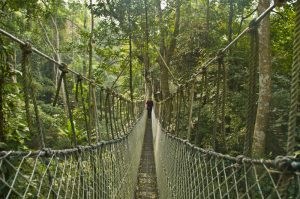
Wangtianshu, one of peculiar tree species in Xishuangbanna State, is distributed in Buwa and Jingpiao in Mengla County, meaning “tree that gazes upon the sky”. These trees reach 70 or 80 meters high in the air. This park north of Mengla has a rickety walkway through the canopy, running from Wangtianshu to Wangtianshu. You must first go to the Air Corridor to experience the thrilling feeling. Then you can appreciate the wonders of the nature in the tropical rainforest. Strolling in the forest, there are so many liana, epiphyte and fern, especially the cruel garrotte phenomena.
The “Air Corridor” in Wangtianshu Scenic Spot is 2.5 kilometers long and 36 meters high. Connected by the bulky iron chains between Wangtianshu, the wooden road surface is laid on the corridor, with ropes protection around. It is breathtaking walking on the corridor. From the corridor, you can enjoy a bird view of the whole rainforest.
◊Cai Xitao Path
Cai Xitao came to Bubeng Village of Mengla County for study on the rainforest and find the Parashorea Cathayensis, improving the existence of rainforest in China. This path is named for the great scientist Cai Xitao.
◊Tropical rainforest
The rainforest exhibits a high bio-diversity beyond one’s imagination. Only the arboreal layer can be further classified into three to four detailed sub-layers. The forest is full of adnascent plants and entwining rattans which can totally extend miles if flattened. Aged stems incredibly bear clusters of blossoms and fruits. In order to get more sun light, lots of herbal plants have grown huge leaves that can shelter several people from the rain.
◊Five Spectacular Sights
There are 5 spectacular sights in the forest park: (1)-Buttressed base roots(板根); (2)-Plants strangling(绞杀); (3)-Old stem bearing blossoms and fruits(老茎怀春); (4)-Parasitic and adnascent plants(寄生附生); (5)-Drip-dip leaves(滴水叶尖).Nanla River
There is a Nanla River in the spot, legendary a place for Shakyamuni Buddha to chant sutras and pour tea. You can take a boat strolling the river, to explore the wonder of rainforest. It is unique from other scenic spots. Usually need 40RMB for one-way boating.
Recommended Tours
3 Days XishuangBanna Hiking Tour to Yao Ethnic Village and The Air Corridor
Best Time to Visit
Belonging to tropical rainforest climate, Xishuangbanna’s dry season is from November to April the next year and rainy season is from May to October. With annual average temperature of 21c, it has long summer and no winter. With cool and pleasant four seasons, the best time for traveling Xishuangbanna is from October to April the next year.
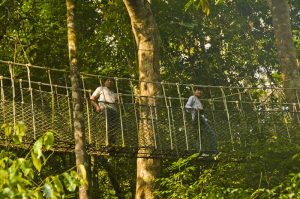
- The Water-Splashing Festival, the most important festival for the Dai People to celebrate New Year, is usually celebrated in the middle of April.
- Try to avoid Chinese public holidays, such as Labor Day (May 1st to 3rd) and National Day (October 1st to 7th). It is recommended that you start your day early so as to avoid crowds.
Nearby Attraction
Menglun Tropical Botanical Garden
Useful Travel Tips
●It is better to prepare some mosquito products and sun block in case of insects and sunlight.
●Respect the local customs of Dai and other minorities.
●The Alianya Water-Splashing Show
The Water-Splashing Festival, New Years Day by Dai calendar, will be celebrated in the Jinghong City Proper between April 12 and 18. The grandest festival of the Dai is usually held along with activities such as dragon-boat racing, sending off skyrockets, and throwing love pouches. It is believed that everyone being splashed at will have good luck. There is a Water-Splashing show in the spot every day. Tourist will have a happy experience to join them.
●Wifi covering
The most convenient of the spot is 80% of the spot covered with WIFI, and the internet speed is very good. You can use the internet without considering PB per month. This is very rare in the domestic scenic spots.
Short Brief and Overview of Donglianhua Mosque
Chinese Name:巍山东莲花清真寺
English Name: Donglianhua Mosque in Weishan County, Dali
Donglianhua Mosque, located in Weishan County, Dali Bai Autonomous Prefecture, is a significant religious and cultural site renowned for its architectural beauty and historical importance. Situated centrally within Weishan County, the mosque serves as a spiritual hub for the local Muslim community.
Historical Background and Architecture
While the precise founding date of Donglianhua Mosque is unclear, it holds a rich history of construction, renovation, and cultural evolution. The mosque exemplifies a fusion of traditional Chinese architectural styles with Islamic influences, showcasing intricate designs and structural elegance.
Travel Tips for Muslim Visitors
If you’re planning to visit Donglianhua Mosque, consider the following tips for an enriching experience:
- Respect Cultural Norms: Dress modestly and respectfully when visiting the mosque. Women may consider wearing a headscarf, and both men and women should avoid revealing clothing.
- Prayer Etiquette: Check the prayer times if you wish to participate in congregational prayers. The mosque hosts regular prayer sessions, providing an opportunity to observe Islamic customs and rituals.
- Historical Exploration: Take time to explore the mosque’s architectural features and historical artifacts. Guided tours may offer insights into its construction, cultural significance, and community role.
- Interact with Locals: Engage respectfully with local worshippers and community members. They can provide valuable insights into the mosque’s role in community life and share stories about its history.
- Photography Guidelines: Obtain permission before taking photographs inside the mosque or of worshippers. Respect any restrictions on photography to maintain the sanctity of the religious space.
Introduction
Donglianhua Mosque, located in Donglianhua Village, Yongjian Town, Weishan Yi and Hui Nationalities Autonomous County, Yunnan Province, is renowned for its historical significance and unique architectural style. Originally built in the early Qing Dynasty, it underwent expansions in 1921 and 1987. The mosque stands as a testament to Islamic history and culture in the region.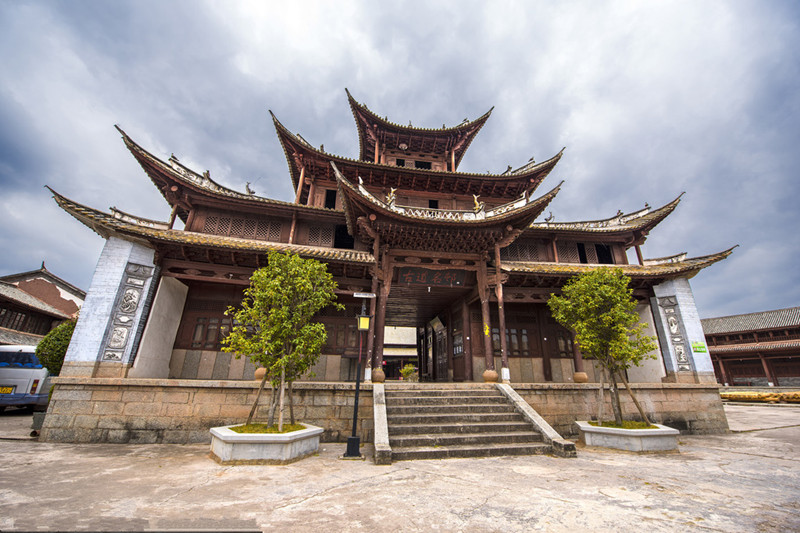
Architecture and Features
Donglianhua Mosque spans an area of 3,000 square meters, featuring a 9-torn and 11-type structure that blends traditional Chinese Palace Culture with Islamic architectural elements. The prayer hall accommodates up to 1,000 worshippers simultaneously. Adorned with white walls, green tiles, intricately decorated beams, and painted rafters, the mosque embodies the elegance and indigenous charm of local ethnic traditions.
Historical and Cultural Significance
Donglianhua Village, historically part of the ancient Tea and Horse Road, is now celebrated for its rich ethnic customs, well-preserved old architecture, and deep cultural heritage as a Muslim village.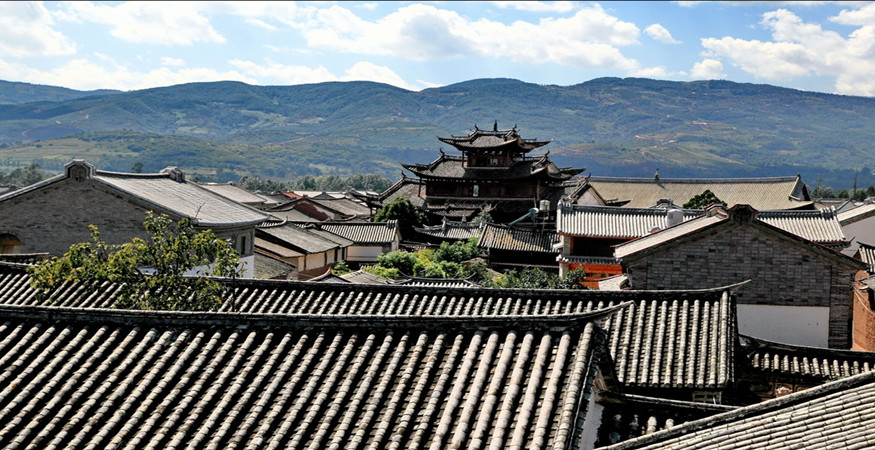
Travel Tips
Transportation:
- From Dali (Xiaguan Town) to Donglianhua Mosque: Take a bus to Weishan County and stop at Yongjian Town. From there, walk to Donglianhua Village.
- From Weishan County to Donglianhua Mosque: Take a bus from Weishan County Bus Station to Yongjian Town and proceed to Donglianhua Village on foot.
These routes offer convenient access to explore the cultural and architectural wonders of Donglianhua Mosque and its surroundings in Weishan County, Dali.
Introduction
Located at Yongdao Street (甬道街), Jingxing Flowers and Birds Market was opened for business in 1983, gathering vendors selling flowers, birds, fish and so on, and finally became the biggest flowers and birds market in Kunming. Local people of the city, especially children getting pocket money during the Spring Festival, like wandering around this oldest flowers and birds market to buy the merchandise they like or shop with eyes only. Yongtong Street is no less than 200 meters long and about 15 meters wide, but there are more than 300 setting booths and about 700 traders. Phoenix trees are planted in line on sides of the road, providing shade for visitors in summer. Besides various kinds of flowers, birds, fishes and pet-insects, item for collection and decoration such as jewels,handcrafts, antiques and commemorative coins are also sold at this market. At least seven to eight groups of foreign visitors can be seen shopping in Jingxing Flowers and Birds Market every day.
The History of Jingxing Flowers and Birds Market
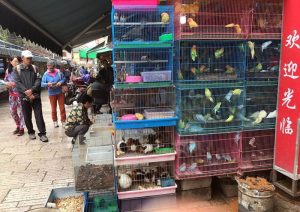
The history of Kunming Ancient Street can be traced back to Song Dynasty (960-1279), while the existing structure, while the street is famous as the only block in Kunming that preserves a large amount of ancient architectures built in Qing Dynasty (1616-1912) and the Republic of China (1912-1949). The architectures there today are essentially important for studying the style and features of mansions and private houses of the periods.
With a history of more than 900 years, Kunming Ancient Street is also a trademark and the last biggest ancient block in Kunming downtown which gains highly attention of local government providing well protection to make sure its sustainable development.
As planned, CNY 3 billion has been invested in the project of Reconstruction of Kunming Ancient Street, which started since 2006 and involved 10 streets including Wenming Street (文明街), JIngxing Street (景星街), Wemiao Straight Street (文庙直街, Confucian Temple Street), Yongdao Street (甬道街), Guanghua Street (光华街), etc. The project aims at creating an AAAA rank Scenic Spots in Kunming. According to official information, the area is called “Old Town Area” or “Preserved Area”.
What to See & Do in Jingxing Flower and Bird Market?
1. Appreciating Flowers, Birds, Fish and Jewelry
Since Jingxing Bird and Flower Market has opened for over 30 years, it has become a mature visiting place with tremendous number of flowers. Many kinds of orchids, various camellias, narcissuses, azaleas, roses, begonias, etc. decorate this market into a very bright and colorful paradise with refreshing fragrance. Moreover, you can find different species of birds chirping along the street, like parrots, crested mynas, thrushes, beyond count, and those types you have never seen, which plays an especially ear-pleasing sound for your Kunming tour.
Besides, you can see a lot of adorable fishes, crabs, turtles, etc. in red, white, yellow, orange, black and other colors having fun in the water. And apart from that, you can still continue your “treasure hunt” in Kunming bird and flower market, since there is a numerous number of jadestones, rubies, sapphires, wood carving works, handicrafts in marble stones, snuff bottles, hookahs, jade ornaments, calligraphies and paintings, coins at home and abroad from ancient to present, etc., which is too many to see all their charm but will give your trip a surprise.
2. Feeling the Interesting Culture
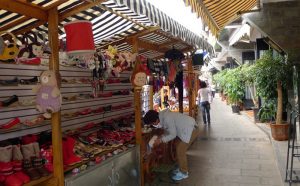
The Flower and Bird Market also acts as a cultural trade center for various kinds of antiques, including jade objects, ink slabs, ancient coins, porcelain, agates, snuff bottles, hookah, Buddha statue, Chairman Mao badge and other handicrafts, which are mainly sold on its second-hand book market and antique market.
3. Tasting the Delicious Local Food
Some other flowers and birds markets in Kunming
1. White Dragon Flowers and Birds Market(白龙花鸟市场): take bus No. 47, 69 or 95, get off at the stop of Shibo Jixinyuan (世博吉鑫园);
2. Western Pets, Flowers and Birds Market(西部宠物花鸟市场): take bus No. 58 or 80, get off at the stop of Xiyuan Keyunzhan (西苑客运站);
3. Chunyuan Flowers and Birds Market(春苑花鸟市场): take bus No. 58, 61 or 62, get off at the stop of Chunyuan Xiaoqu (春苑小区);
4. Daguan Flowers, Birds and Insect Market(大观花鸟虫市场): take bus No. 125, or 160, get off at the stop of Daguan Shangyecheng (大观商业城);
5. Golden Tree Village Flowers and Birds Market(金树村花鸟市场): take bus No. 47, or 50, get off at the stop of Xinying Lukou(新迎路口/人民东路);
6. Jingxing Flowers and Birds Market(景星花鸟市场): take bus No. 10, or 82, get off at the stop of Nanpingjie Xikou(南屏街西口);
7. Dounan Flowers Trading Market(斗南花卉交易市场): take bus No. 12 get off at the stop of Beimen Jiekou (北门街口), then take bus 215 get off at the bus stop of Dounan (斗南);
8. Expo Garden Flowers and Birds Market(世博园花鸟市场): take bus No. 47, 69 or 95, get off at the stop of Shibo Jixinyuan (世博吉鑫园);
9. Little Dragon Sifang Street Flowers and Birds Market(小龙四方街花鸟市场): take bus No. 60 or 95, get off at the stop of Xinying Lukou(新迎路口/白龙路);
10. Zhongbei Flowers and Birds Market(中北花鸟市场): take bus No. 99 or 171, get off at the stop of Jinyuan Huayuan(锦苑花园).
How to Get to Jingxing Bird and Flower Market
By Bus
It is located at downtown Kunming and not far away from Kunming Department Store and Nanping Pedestrian Street (南屏步行街). Travelers can take bus No.1, 2, 4, 5, 10, 26 or 52, or take a taxi.
By Subway
Tourists can take Subway Line.2 to Dongfeng Square, then we can walk to Jingxing Bird and Flower Markets.
Private Tour (Top Recommended)
If you want to get rid of hustle of public transportation and troublesome navigation, you can book a private tour package which covers sightseeing, dining and transfer from us. Our local tour guide and driver will escort you to Jingxing Bird and Flower Market with speed and convenience, and take care of all the details. You just need to focus on sightseeing.
Travel Tips
1. Measure system in Kunming is different from that of other cities. Traders in Kunming always quote at 1 kilogram per unit while traders in other China cities will quote at 500 gram per unit. Please make sure the unit price before you buy anything.
2. Besides flowers, birds, fish and pet-insect, many folk arts and crafts are selling in Jingxing Flowers and Birds Market which is surrounding by large numbers of most well-preserved ancient architectures in Kunming.
The Cloud Sea Wonder of Wa Ethnic Mountain in Ximeng County, Puer
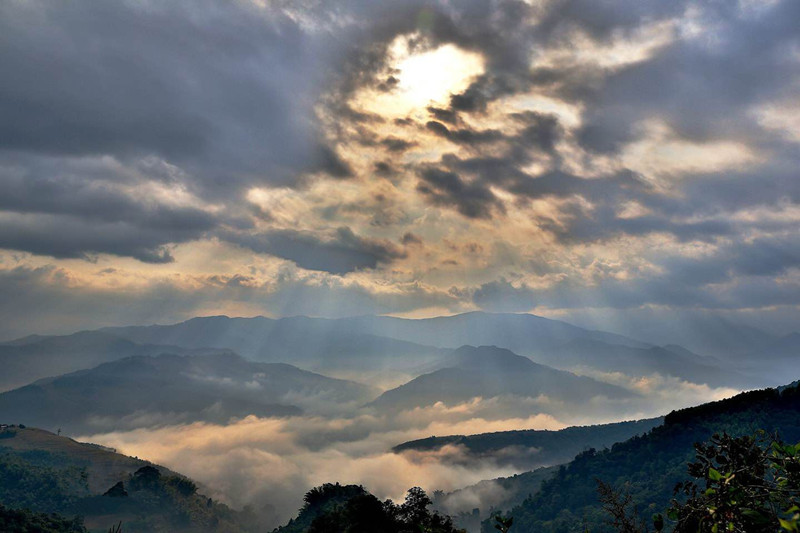
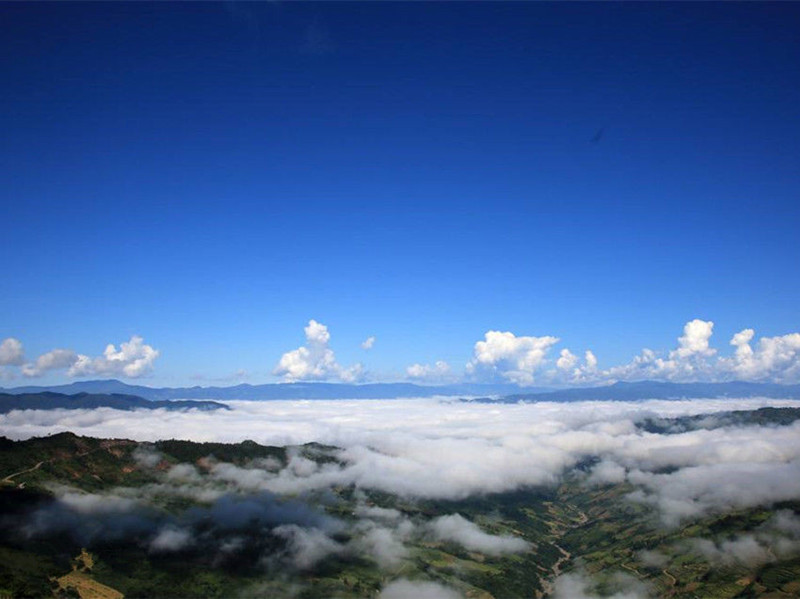
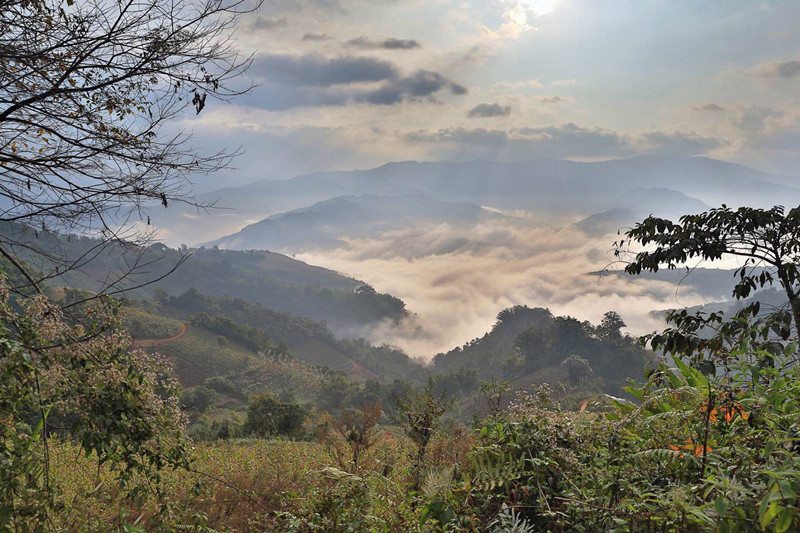
Chinese Name:凤庆县滇红生态产业园
English Name:Dianhong Eco-industrial Park in Fengqing County, Lincang
Fengqing Dian Hong (Dianhong Group) 凤庆滇红 : This company was established in 1954. The factories are located in the Feng Qing and Geng Ma 耿马 counties of Lincang 临沧. This company is recognized as maintaining a solid reputation and is renowned for breeding hundreds of varieties of Camellia Sinensis trees. Their main specialty is their cultivation of high-quality black teas (red tea 红茶) from old Lincang tea trees.
Yiwu Tea Mountain in Mengla County, Xishuangbanna
Yiwu,The Hometown of Pu’er Tea. Yiwu Town is situated in the north of Mengla County, Xishuangbanna Prefecture. It is the hometown of Pu’er Tea as well as the starting...
Zhanglang Bulang Ethnic Minority Village, Xishuangbanna
Zhanglang Bulang Ethnic Minority Village Zhanglang Bulang Ethnic Minority Village(章朗布朗古寨) is the only one Bulang ecologic museum in China. The Bulang people have been inhabitants of the area for...
Nannuo Tea Mountain in Menghai County, Xishuangbanna
Nannuo Tea Mountain Nannuo Mountain is famous in China and abroad as the home of the “King of Tea Tree,” a human cultivated 800+ year old tree. Fine tea...
Nianhu Lake in Huize County, Qujing
Chinese Name: 会泽念湖 English Name: Nianhu Lake in Huize County, Qujing Nianhu Lake is located at the junction of Daqiao Township in Huize County, Qujing City, and Zhaotong. It is a...
Junzi Mountain in Shizong County, Qujing
Chinese Name:师宗县菌子山 English Name: Junzi Mountain in Shizong County, Qujing Location:...
Huize Ancient Town, Qujing
Chinese Name: 会泽古城 English Name: Huize Ancient Town, Qujing 可以直接去看百度百科 http://baike.baidu.com/link?url=pqEpevzLRcEe30_WVlnhEZ5fEQIhSxLvFyJX6c5_6zT5op7OO93JndGFUy07joO6xmwW6BMuLVOB_Wm05waFvdcKSJbq6mVGqEwmz41Goa-InmzDAG4i-ZYUDlF7rWKf 会泽古城,位于云 ...
Laodabao Village of Jiujing Town in Lancang County, Puer
Laodabao and ‘Happy Lahu’ Laodabao Village(老达保寨), located in the southeast of Lincang County, is 42KM from the county. It is a typical Lahu Village with all the 114 families/473...
WangTianShu Scenic Spot in Mengla County,XishuangBanna
Wangtianshu Scenic Spot Wangtianshu Scenic Attraction is the only oasis at 21 degrees north latitude, and has been recognized internationally as China’s unique tropical rainforest. What is the most...
Donglianhua Mosque in Weishan County, Dali
Short Brief and Overview of Donglianhua Mosque Chinese Name:巍山东莲花清真寺 English Name: Donglianhua Mosque in Weishan County, Dali Donglianhua Mosque, located in Weishan County, Dali Bai Autonomous Prefecture, is a significant...
Jingxing Flowers and Birds Market in Kunming
Introduction Located at Yongdao Street (甬道街), Jingxing Flowers and Birds Market was opened for business in 1983, gathering vendors selling flowers, birds, fish and so on, and finally became...
The Cloud Sea Wonder of Wa Ethnic Mountain in Ximeng County, Puer
The Cloud Sea Wonder of Wa Ethnic Mountain in Ximeng County, Puer...
Dianhong Eco-industrial Park in Fengqing County, Lincang
Chinese Name:凤庆县滇红生态产业园 English Name:Dianhong Eco-industrial Park in Fengqing County, Lincang Fengqing Dian Hong (Dianhong Group) 凤庆滇红 : This company was established in 1954. The factories are located in the...
Tips Before Travel
Bring copies of your passport
Don't assume you're restricted to the main hubs of Beijing and Shanghai, our tours can start from any city.
Register with your embassy
For your safety, please register with the Embassy.
Always have local cash
Exchange some local currency for your trip
Our Team
Customize a Trip
Start planning your tailor-made holiday to China by contacting one of our specialists. Once enquired, you’ll get a response within 0.5~23.5 hours.
